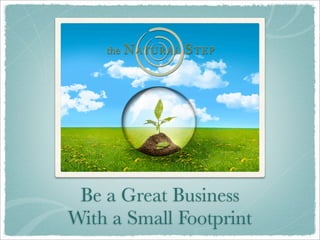
Be a Great Business with a Small Footprint
- 1. Be a Great Business With a Small Footprint
- 2. Sustainability Meeting the needs of the present without compromising the ability of future generations to meet their own needs.
- 3. Three elements are necessary for sustainability: Economic Environmental Societal
- 6. Developed by Dr. Karl-Henrik Robèrt in 1989, the TNS Framework builds on a basic understanding of what makes life possible, how our biosphere functions and how we are part of the earth’s natural systems.
- 7. Four System Conditions 1. Eliminate contribution to fossil fuel dependence and to wasteful use of scarce metals and minerals. Reduce mining and bringing into use substances from earth’s crust: • heavy metals such as cadmium, lead, mercury, • minerals such as phosphorus • fossil fuels These substances and their emissions (CO2 and NOx) are steadily increasing in human society and nature.
- 8. 2. Eliminate contribution to dependence upon persistent chemicals and wasteful use of synthetic substances. • Humans are manufacturing synthetic substances faster than they can be broken down. • EPA lists more than 70,000 chemicals that are in common use. • Every U.S. citizen’s fatty tissue contains at least 700 chemical contaminants, according to EPA.
- 9. 3. Eliminate contribution to encroachment upon nature – land, water, wildlife, forests, soil, ecosystems. • Human activity is breaking down natural systems faster than they can renew themselves. • Nearly one-half of the Earth’s original forest cover has been lost. • Demand for fresh water exceeds the world’s supply by 17 percent.
- 10. 4. Meet human needs fairly and efficiently. • If people around the world cannot meet their basic human needs (air, water, food, shelter), the first three system conditions will not be met. • Within our businesses & communities, our needs include: • a means of a livelihood • mobility • equal treatment • equal access • participation in decisions • safety • right to peaceful enjoyment of life • connection with nature
- 11. Three Steps to a Sustainable Business
- 12. Step One Backcast: Determine how your company will look when it’s completely sustainable. How are you going to get there? What will have to change?
- 13. Backcasting Create Awareness Develop Baseline Envision the Future Set and Manage Priorities
- 14. Priority Setting in D Search for measures that respond “yes” to these three questions: 1. Does this measure proceed in the right direction with respect to all system conditions? 2. Does this measure provide a stepping-stone for future improvements? 3. Is this measure likely to produce a sufficient return on investment to further catalyze the process?
- 15. Step Two Select an implementation structure/strategy for incorporating sustainable practices into your operations.
- 16. Step Three Create a measurement tool to track your sustainability initiatives.
- 17. Business Applications Energy Conservation Material Sourcing Land Use Transportation Water Conservation Solid Waste Reduction Air Quality Storm Water Impact Life Cycle/Cradle to Cradle
- 18. By Department Landscaping Facilities Maintenance Fleet Management Indoor/Outdoor Lighting Purchasing Heating/Cooling Shipping Toilets/Sinks Cafeteria Janitorial Human Resources Interiors Manufacturing Carpet, Paint, Furniture Upstream & Downstream Responsibility for Sustainable Materials
- 19. Questions? Lori De La Cruz, ABC Blue Marble Media, LLC & The Ecological Compass Lori@BlueMarbleMedia.net 817-233-4093
